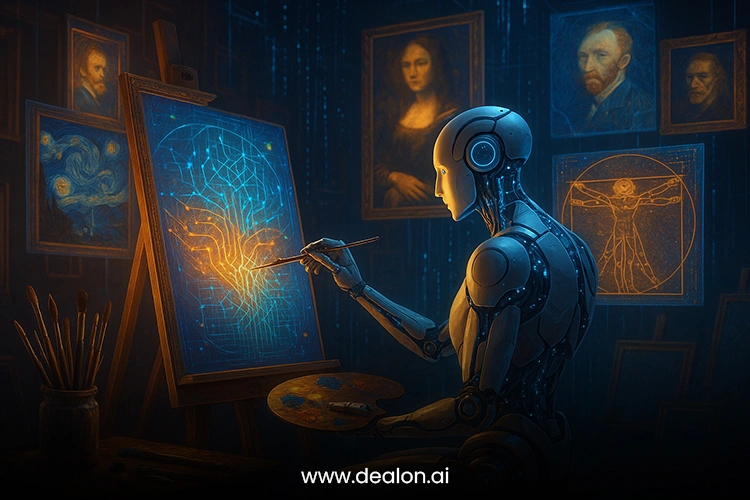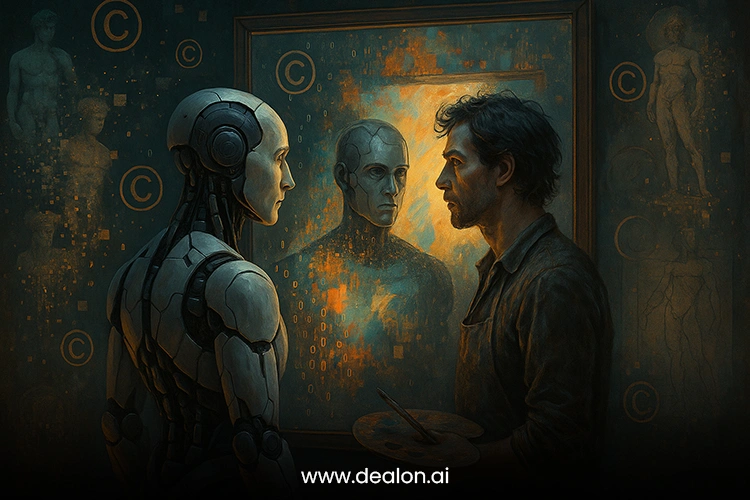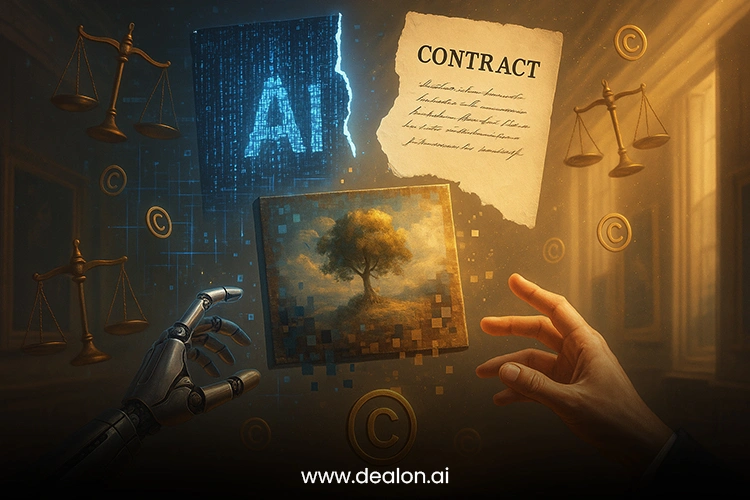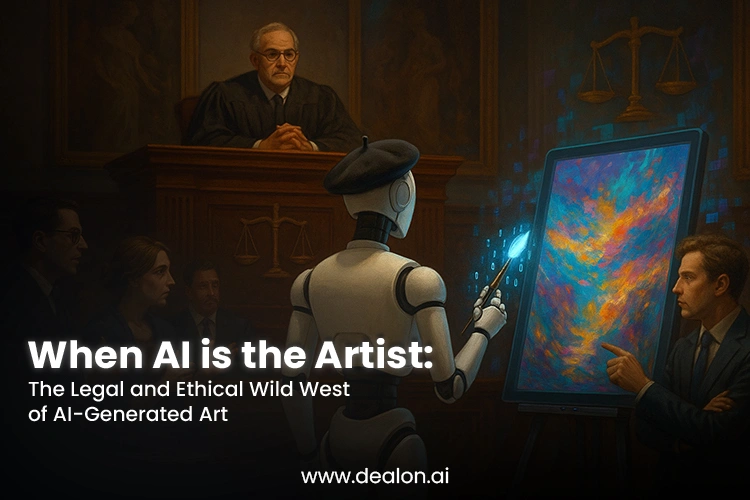Artificial intelligence (AI) came into the world and introduced a paradigm shift in every industry, and the art world is no exception. AI is no longer a tool to help human artists; it is a creator itself. The question that will be raised is that with AI models like DALLE, MidJourney, and DeepArt creating visually engaging art, where AI is the artist, what happens to the conventional definition of creativity, authorship, and intellectual property? Art created by AI is obliterating the boundaries between human and machine art, and the ethical and legal issues surrounding it are posing deep questions.
The central issue of this revolution is authorship: who, or what, is to be regarded as the creator of a work of art developed by an algorithm? Is it the fault of the programmer that created the AI, the user that instructed the creation, or the AI itself? Moreover, the fact that AI depends on massive data sets of already existing pieces of art makes the situation complicated, as it raises the question of the usage of copyrighted content without the relevant reference.
The concept of AI art goes further than authorship to question our sense of creativity. Traditional art is viewed to be a projection of the personal experience, emotional richness, and personal outlook. However, it is with AI-generated art that does not possess these human qualities that a new reality emerges, where the new notion of originality is challenged. The latest technologies have led to debates concerning the morality of using AI to reproduce the artistic works of the masters in the past, and therefore, undermining the human element in creative art.
The artistic world is evolving under the influence of AI, and we have to find our way through the tricky legal and ethical minefield that challenges the matter of creative expression and copyright. The emergence of AI as an artist is challenging us to reconsider the role of creating, owning, and appreciating art during an era of digital technology.
Also Read: No-Code AI: How You Can Build AI Tools Without a Ph.D. in Computer Science
The Birth of AI as an Artist

The area of AI in art is already a futuristic dream, but it is a real situation, and the influence of such a technological revolution on art is significant. Increasingly, with the emergence of generative adversarial networks (GANs) as well as advanced machine learning systems, AI is now capable of generating art that competes with and sometimes even outperforms art created by human hands. Such algorithms work based on large volumes of existing art, extracting patterns, color schemes, brush strokes, and stylistic subtleties. Based on this information, AI can create purely novel works of art that have aesthetic worth, both in digital paintings and complex designs.
The consequences of the role of AI in art are much more far-reaching than its capacity to replicate human creativity. The idea of the machine producing something of artistic value goes against the principal fabric of our understanding of art. If an algorithm creates a painting, who is the owner of the painting? Who is the creator of the machine that made the piece of artwork, or the algorithm creator who wrote the program, or even the person who typed in the parameters? This indecision represents one of the most important ethical and legal challenges of the art community these days, as it makes us reconsider the traditional notions of originality, authorship, and creativity.
Ethical Dilemmas: Identity Crisis of the Creator

The question of authorship is also one of the most complicated ethical problems in the field of AI-generated art. Historically, art making is perceived to be a form of human experience, and the individuality of the artist and his or her vision of the work are the key points. The art is commonly considered a path to the soul of its creator, which is filled with emotions, thoughts, and intentions that are highly personal. This human identity, however, is not present in the case of AI-generated art. The AI does not possess any internal feelings, experiences, or wishes that shape its creations. This brings about a question: who should own the masterpiece by the AI as it is created?
It only becomes more complicated when we look at the data sets that train AI systems. Millions of existing artworks are often used to create an AI model, with the original creator usually unaware of this usage. These data may contain popular paintings, sculptures, or even digital art of the modern era, to which the AI then applies to reproduce, adapt, or repurpose these styles.
This brings out essential issues concerning intellectual property rights and the ethics of using another person’s work as a basis for formulating a new work. When an AI model produces an artwork that has the appearance of being quite like the style of a famous artist, should it be considered that the AI is only stealing the work of that artist, or does it enter into the sphere of exploitation?
Moreover, AI-created art is a threat to the classical concept of originality, which is one of the foundations of artistic value. In the art world, originality is valued as it symbolizes novelty, originality, and human creative drive of the human mind. Instead, AI is not really able to produce something completely new. Rather, it is conditioned to work on existing work, and it is constrained by the information it has been nourished with.
Although AI can generate stunning compositions, the originality of such works is frequently questioned. Is it a piece that is original when it is all patterns and influences of other artists? And does this take away the artistic value that human creators add by lived experience, emotion, and personal vision?
Moreover, human artists apply their experiences, values, and emotions in their works, and this tends to create art that resonates with the audience on a visceral level. The opposite is true of AI, which lacks these human attributes. Although it can copy forms, styles, and techniques, it lacks the emotional depth and purpose of its creations. Critics of this non-emotional and non-personal nature have argued that the work done by AI is worse than what is produced by a human being. This leads to the question: Can art, which does not have any soul, be viewed as legitimate?
The art created by AI, therefore, makes us question the very definition of what art is. Does the value of the piece of work lie in its aesthetic value or in the human factor in which the work was created, giving it a sense of purpose? The question of authorship, originality, and the level of emotion is the focal point in the discussion of the influence of AI in the artistic world.
Although AI may be an opening into a new arena of creative potentials, it is also a shock to our most cherished beliefs about creativity and the essence of the artistic form. The boundaries between human and machine-generated art will only become even less distinct as the art world struggles with these questions, and what it takes to be an artist in the age of AI will be redrawing its boundaries.
Legal Minefields: AI-generated art owned by who?

The emergence of AI-generated art has presented numerous problems in terms of legal issues, especially ownership and intellectual property (IP) rights. Conventionally, the copyright law has been explicit in giving properties to the human being who creates a work, and the creator is entitled to some exclusive rights. Nonetheless, the issue of ownership of a work of art produced by an algorithm remains a more complicated question, as AI technologies keep getting advanced. AI, as a machine learning system, is an autonomous machine to create art; however, the machine does not have the legal authority to own its works or have rights to them.
Existing copyright regulations cannot deal with the situation where an AI system is the only creator of work. The majority of legal systems attribute the right to the ownership of the copyright to the individual, and it is hard to define AI as a legitimate rightful owner in the framework of traditional systems. Due to this, the question of ownership enters the grey area of law.
Is it the developer of the AI system, the user who fed the AI the instructions, or even the AI itself that should be considered the owner? These questions are highly legal ambiguities that courts are finding it difficult to decide how the intellectual property laws apply to AI-generated work.
Among the examples, in 2018, the artificial intelligence-created art piece Edmond de Belamy was sold at a Christie’s auction for more than half a million dollars, raising a lot of controversy about who should own the rights to the work. Although the painting was created by the AI system known as Obvious, created by a group of French artists, the scandal occurred about whether the painting was rightfully owned by the AI or the creators of the algorithm used to make it.
This scenario begged some critical questions, namely, whether the value of the artwork can be attributed to the creativity of the AI or to the human engineers who coded the AI. The sale of Edmond de Belamy* revealed that legal frameworks are urgently required that can respond to the role of AI in the production of art, and this uncertainty indicates the increasing demand for new legislation specific to AI-generated artworks.
The Future of AI Art: Walking the Line of legal and ethical landscape
With the growing role of AI in the creative industry, the question of the legality and ethical concerns of AI-generated artwork is becoming more and more pressing. The application of intellectual property rights to these new creations will largely depend on legal reforms, but several possible solutions have the potential to guide through the complexities.
The possible solution is the creation of the rules according to which AI is called a medium in the artistic process and not as an autonomous creator. Under this type of system, the creators of human beings would own the work, with the AI being a tool that is utilized in the creative process, just as other traditional tools such as paintbrushes or cameras.
This would explain attribution and would guarantee that human creators retain ownership of their works, and also the vitality of AI technology in creating the work. This sort of differentiation would save the rights of human artists and avoid the establishment of a legal vacuum in which nobody is going to be held responsible for AI-generated art.
The other possible solution to the legal issue is to consider AI-generated works as any other work produced by a human assistant or a human partner. Under this model, credit would be assigned to the human participant who influenced or steered the AI, although it would be acknowledged that the machine was an essential part of the creative process.
This is the model of how the copyright laws are treating works that are co-authored by people and non-human participants, such as assistants, editors, and other tools. The rights of the human creator in this case would be retained, and the input of the machine would be acknowledged, which would form a just and open system to handle the ownership of AI art.
One of the most critical aspects of the solution to the ownership problem of AI-generated art is the use of data. Most AI models are trained using large datasets of existing art, usually obtained online or belonging to private collections. This raises questions about whether the training datasets are ethically obtained and whether the original authors of the works that were used to train the AI have been compensated or notified.
With the increased participation of AI in the process of creating art, developers and artists should establish ethical guidelines in using datasets and ensure that the rights are not violated through it, as well as give the artists credit for their work. Also, it is necessary to have the transparency of these datasets. The artists and the consumers must be assured that the AI models do not violate the works of others without giving them the necessary authorization and attribution.
Conclusion
AI-created art is transforming the creative world and posing complicated ethical and legal dilemmas on the subject of authorship, ownership, and originality. With self-generating art, the traditional copyright laws cannot adapt to the new realities, and it is not clear where the rights to the AI-generated works belong. The future of AI art is to develop proper legal frameworks to designate AI as a subject but not a creator, leaving the ownership of the aesthetics to human creators, yet with the contribution of AI. The legal and moral minefields in data use and transparency will also require ethical standards to navigate legal and moral issues responsibly.

